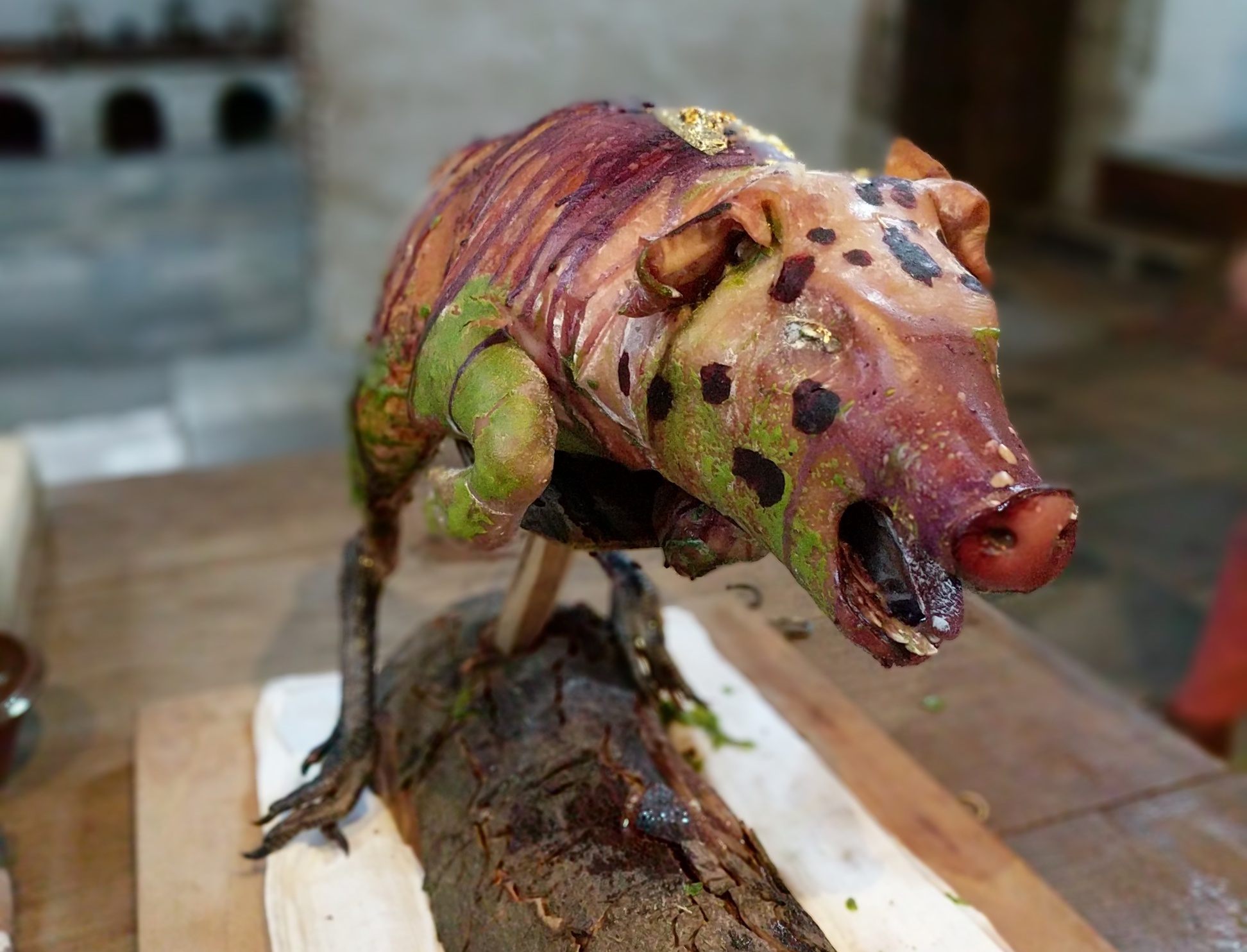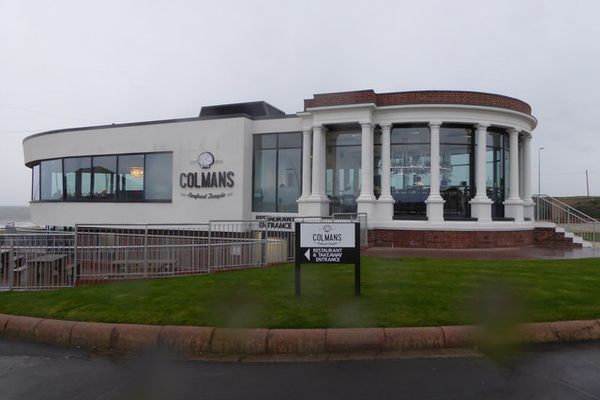The Historians Cooking Up Mythical Beasts
Making a cokentryce calls for needle, thread, and a lot of meat.

Built in the 16th century, Hampton Court Palace is the largest surviving palace of the time. Notable for being able to fit the entire royal court of its owner, Henry VIII, it’s also a mix of two styles (Tudor and Baroque), a legacy of a partial renovation. But its main kitchen, once the largest in Tudor England, was left unremodeled. In these frozen-in-time rooms, a team of historian-cooks still turns out food fit for royalty, including a roasted mythical beast, the cokentryce.
While the cokentryce never existed, many Europeans once believed it was a real animal. According to Historic Kitchens manager Richard Fitch, “it has the body of a rooster and the back of a pig.” The cokentryce was said to be a relative of the scaly, deadly basilisk, so some depictions included a snake’s tail. From a 15th-century perspective, Fitch says, “These animals truly exist. They might not exist in their country, but they exist somewhere in the world.” Medieval European writers and artists described and sketched many a cokentryce, and the beast is even mentioned several times in the King James version of the Bible as a venomous creature.

Their nonexistence didn’t stop people from trying to eat them. Multiple recipes from the period describe how to make your very own cokentryce. Cooks who wanted to present a mythical creature on their lord’s table sewed together pigs and chickens. With clever stitches, careful roasting, and disguising garnishes, medieval and perhaps even Tudor cooks created surprisingly realistic cokentryces, which they presented with the intent to awe.
At least, that’s what Fitch thinks. His Historic Kitchens team made nine cokentryces last month, appropriately on the week before Halloween. It was their latest foray in years of making mythical roasts from 15th-century medieval recipes, and their guiding principle is realism: The cokentryce should look as if it walked and breathed before being butchered. The team succeeded—guests walking through the Hampton Court Palace kitchen asked about the unfamiliar animal roasting on the spit.
To Fitch, these reactions reflect the purpose of the original cokentryce. For rulers, they demonstrated power, even at dinner. In many sources, cokentryces are described as a meat for royalty. “You are quite literally providing fiction for people,” says Fitch. “You’re providing a myth that people can consume.” The time and artistry needed to create a cokentryce also displayed wealth and social status.

Since the Historic Kitchens team uses traditional techniques to demonstrate vintage cuisine, their cokentryces called for just as much effort, if not more. Fitch relates years of trial and error: The team first made cokentryces more than 20 years ago. Many historical recipes provide limited explanation, and the team strives to interpret them as accurately as possible.
Still, certain allowances for modernity had to be made. Fitch and his team made their cokentryces with turkeys, not chickens. Royal chefs used the large, meaty capon: a castrated rooster. But while the castration results in a larger, fatter bird, the practice is considered inhumane under modern British law. Plus, Fitch notes, modern rearing practices mean many chickens have weak bones and thin skin, making them bad material for a meat sculpture.

With a turkey and a suckling pig from the local butcher, the assembly of a cokentryce can begin. Typically, Fitch says, the cooks divide the pig and the turkey into two parts, a front and hindquarters. The division is done carefully. The two halves need to be of similar dimension, with plenty of skin left over for sewing the sections together with a blanket stitch: the front of the pig to the bird, or vice-versa. The two halves of the cokentryce are connected with a metal wire in the spinal columns of both animals (this also makes them more pose-able). Then, the cooks stuff the cokentryce with bread, and arrange it on the spit carefully: Once it’s roasted, it can’t be re-posed. Once paper is tied to the appendages of the cokentryce to keep them from burning, someone must laboriously turn the spit until it’s fully cooked.

But there’s one final step that really ups the realism factor. Just before it’s taken off the spit, the cokentryce is covered in colorful batter. Whether red, green, or gold, the batter creates a skin-like tone and disguises the stitching. Finally, the cokentryces are decorated with care. The team gave one dual-headed cokentryce feathery wings, while they posed another with an adversary: a weasel made of beef, since weasels were supposedly the cokentryce’s natural enemy.
Throughout the process, visitors to Hampton Court Palace watched the team work. “They are asked to look at the different ways that people viewed animals in the past,” Fitch says. When The Atlantic reported on the Hampton Court Palace cokentryce in 2013, it resulted in protests that the practice was gruesome. Fitch puts that down to the cokentryce retaining its head, unlike a chicken cutlet or pork chop. “When it’s got a head and face on, it’s very difficult to disconnect the thought process of eating a piece of chicken from eating an animal,” he says.
But Fitch notes that there’s always an element of surprise to their cooking demonstrations, no matter what is prepared. “The fact that we have costumed staff who are cooking real food using real ingredients in front of people is still a shock.”
Gastro Obscura covers the world’s most wondrous food and drink.
Sign up for our regular newsletter.

























Follow us on Twitter to get the latest on the world's hidden wonders.
Like us on Facebook to get the latest on the world's hidden wonders.
Follow us on Twitter Like us on Facebook